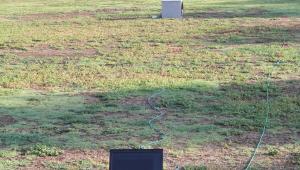Review: MSR Acoustics Dimension4 Melody Room Treatment System Page 2
More effect, less bulk
Dimension4 is the result both of PMI’s experience in acoustical design and its search for acoustical treatment devices that don’t take up loads of space. “We started by taking the findings of a very studied acoustical design approach, implemented hundreds of times,” Grimani explained. “Then we went through a long process of trial and error, applying science and listening tests until we got something that worked.”
The Dimension4 Melody system comprises two basic types of products: absorbers and diffusers. The absorbers absorb sound, i.e., they remove sound energy from the room. The diffusers reflect sound while also breaking it up, eliminating annoying “flutter echo” while also creating a pleasing, ambient sonic environment.
An absorber normally needs to be at least 4 inches thick to work sufficiently down into midrange frequencies, but the absorbers in the Melody system are just half that depth. Grimani explained how they work. “You can remove sound energy from a room in different ways, but they’re loosely lumped into two methods. There’s friction, where air molecules meet fiber or foam and create heat; and resonators, where acoustical energy interacts with a material that resonates mechanically or acoustically to create heat.”
The patented Dimension4 absorbers work their magic by combining both methods. Inside is a rock wool core, which provides frictional absorption. The wool core is surrounded by fiberglass matting, which provides a resonant tympanic membrane. According to Grimani, the two work together to provide absorption down to 300 Hz, compared to 500 Hz for a typical 2-inch fiberglass panel.
Each absorber measures 35.5 by 23.75 by 2 inches. They can be mounted on walls or suspended from a ceiling.
There’s also a bass absorber version designed with angled edges to mount in a corner. Because there’s air space behind it, it works down to lower frequencies; Grimani said the response is -3 dB at frequencies from 100 to 400 Hz, and -6 dB at 50 Hz. An extra reflective layer prevents frequencies above 400 Hz from being absorbed.
You may have seen diffusers in photos of studios or serious listening rooms. Most of them use irregular surfaces; some resemble city skylines. According to Toole’s book, in order for a typical commercially available diffuser to work down into midrange frequencies, it needs to be about 8 inches thick. Yet the Dimension4 diffusers are just 2 inches thick.
The diffusers are actually made from absorptive material; what makes it diffusive is the angled front. But while you might think the angle is intended to make sound hitting the wall reflect in a different direction, it doesn’t work that way. “The thinner edge of the diffuser absorbs only higher frequencies,” Grimani said. “We interleave the diffusers with areas of bare wall. The reflection off the wall is full-band, with its phase unaltered. But the reflection off the diffuser strip is low-passed [i.e., the high frequencies are filtered out], which gives it a different phase response. The combination of the two different phases of sound gives you diffusion.
“It works down to about 800 Hz,” he continued. “We’d love to have it work down to 300 Hz, which is what we do in our higher-end systems, but there is a cost and bulk requirement to that.
The diffusers measure 35.5 by 6 inches, and the thickness runs from 2 inches on one side to 1 inch on the other. They’re typically placed on a wall in groups of two to four, with a few inches of space between strips.
- Log in or register to post comments




































































